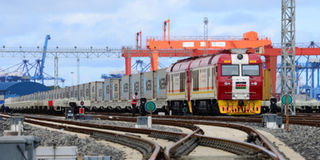How the Chinese firms became true winners of Kenya's SGR project

What you need to know:
· For every 7.8 tonnes of cargo ferried inland by the trains, just 1.01 tonnes is railed back to the port, scuttling hopes that Kenya would benefit by using the line to export goods.
· This has fanned fears that the Chinese have turned the railway into a convenient tool to ship in cheap imports.
The influx of such imports has been flagged for being detrimental to the country’s industrialisation, with manufacturing being one of President Uhuru Kenyatta’s legacy projects.
The Standard Gauge Railway has remained largely an import tool used to ferry cargo from the Mombasa port with very little being shipped back, according to operations data from Kenya Railways Corporation.
SWEETHEART DEAL
The data show that for every 7.8 tonnes of cargo ferried inland by the trains, just 1.01 tonnes is railed back to the port, scuttling hopes that Kenya would benefit by using the line to export goods. This has fanned fears that the Chinese have turned the railway into a convenient tool to ship in cheap imports.
The influx of such imports has been flagged for being detrimental to the country’s industrialisation, with manufacturing being one of President Uhuru Kenyatta’s legacy projects.
Between January 2018 when the SGR cargo freight services started and April 2019, some 3.7 million tonnes have left the port through the railway service with only 484,197 tonnes ferried back via SGR, according to internal analysis by Kenya Railways Corporation (KRC).
The data obtained by DAILY Nation also shows that the government was ferrying close to 300 containers every month on SGR after a circular was issued in mid-2018, compelling all government departments to use the SGR in transporting cargo from Mombasa.
An operations contract signed between the China Roads and Bridges Corporation and KRC detailed in a Sunday Nation expose saddled Kenya Railways with heavy operations and maintenance fees, many of which are highly variable.
Under the deal, which allowed a special purpose operating company to be registered in Kenya to run the SGR, Kenya Railways was compelled to lend the Chinese operator Sh3.5 billion in a sweetheart deal without any interest on repayment and generous grace period.
The operator does not have to pay back the money in cash. Instead, a highly variable service payment structure is used to cancel out the debt in a unique case where Kenya became the lender to the Chinese company, who built the railway line at over Sh400 billion.
SERVICES FEES
The railway operator, which incidentally built the line, was paid Sh1.3 billion to mobilise equipment and familiarise with the site, which it had worked in for close to four years, according to the secret pact.
A special reserve account was also set to be maintained with Sh3 billion as part of the starting preconditions to cushion the operator’s cash flow. This is set to rise to Sh4 billion from next year.
Even sweeter for CRBC, the operating company — Africa Star Railway Operations Company, registered in Kenya — has been used to relieve the Chinese operator from any liabilities under the contract.
In fact, even where some financial culpability has been found on CRBC, it cannot be made to pay more than 10 per cent of what it earns as quarterly fixed services fees, even if the losses are from the operator’s fault.
Furthermore, the operator was only required to give a performance bond of Sh600 million.
The monthly payments, which are made in a mix of Kenya shillings and US dollars, averages Sh1.8 billion every month.
Compared to the Sh5.7 billion SGR made in its first year of operation, the future of the project, whose loans are due from January 2020, remains grim.
The special purpose operating company has CRBC as the majority shareholder but details of other owners said to comprise locals remain scanty. Insiders say local partners comprise influential government officials in the Transport ministry and powerful politicians.




